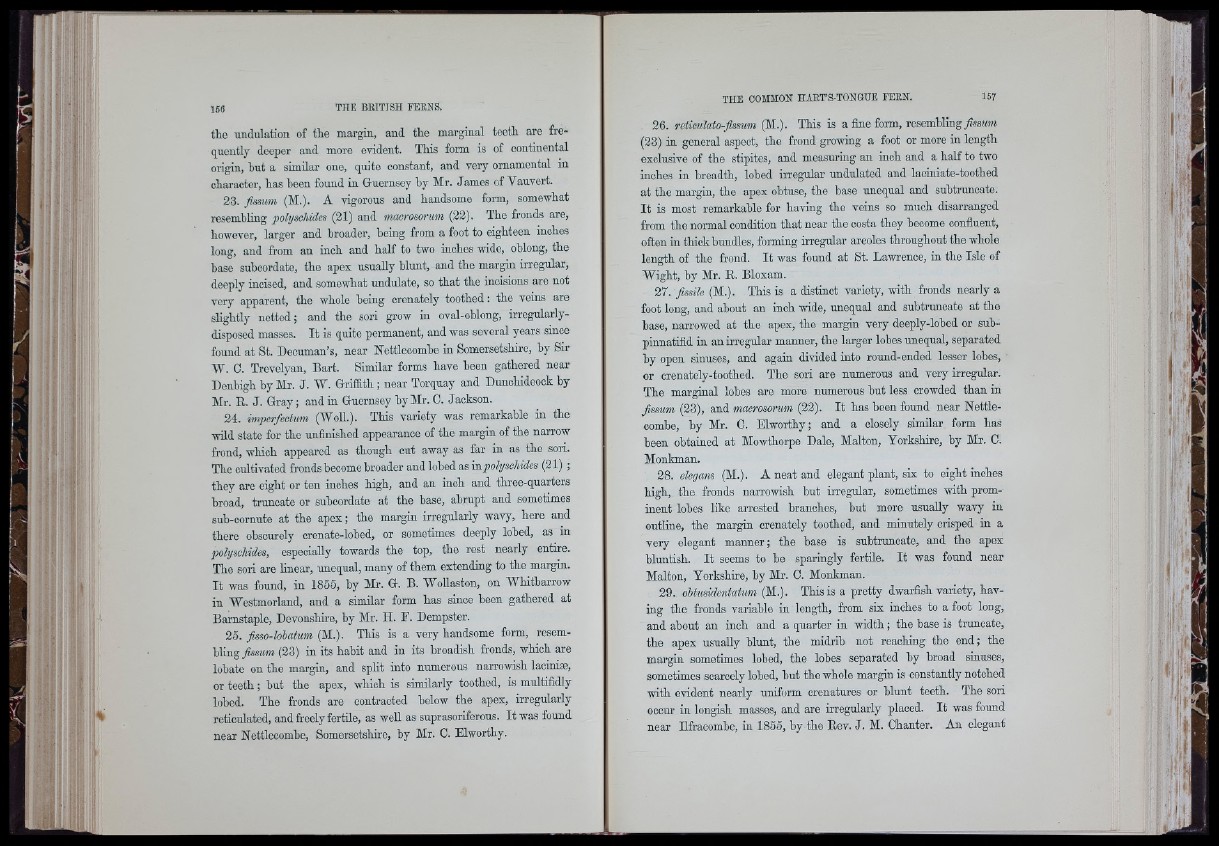
tho undulation of the margin, and tho marginal teeth are frequently
deeper and moro evident. This form is of continental
origin, but a similar one, quite constant, and very ornamental in
character, has been found in Guernsey by Mr. James of Vauvert.
23. fissum (M.). A vigorous and handsome form, somewhat
resembling polyschides (21) and macrosorum (22). The fronds are,
however, larger and broader, being from a foot to eighteen inches
long, and from an inch and half to two inches wide, oblong, the
base subcordate, the apex usually blunt, and the margin irregular,
deeply incised, and somewhat undulate, so that the incisions are not
very apparent, the whole being crenately toothed : the veins are
slightly netted; and the sori grow in oval-oblong, irregularly-
disposed masses. It is quite permanent, and was several years smoe
found at St. Decuman’g, near Nettlecombe in Somersetshire, by Sir
W. 0. Trevelyan, Bart. Similar forms have been gathered near
Denbigh by Mr. J. W. Griffith ; near Torquay and Dunchideock by
Mr. B. J. Gray; and in Guernsey by Mr. 0. Jaokson.
24. itnperfectum (Well.). This variety was remarkable in the
wild state for the unfinished appearance of the margin of the narrow
frond, which appeared as though out away as far in as tho sori.
The cultivated fronds become broader and lobed as mpolyschides (21) ;
they are eight or ten inches high, and an inch and three-quarters
broad, truncate or subcordate at the base, abrupt and sometimes
sub-cornute at the apex; the margin irregularly wavy, here and
there obscurely crenate-lobed, or sometimes deeply lobed, as in
polyschides, especially towards the top, the rest nearly entire.
The sori are linear, unequal, many of them extending to the margin.
I t was found, in 1855, by Mr. G. B. WoUaston, on Whitbarrow
in Westmorland, and a similar form has since been gathered at
Barnstaple, Devonshire, by Mr. H. F. Dempster.
25. fisso-lohatum (M.). This is a very handsome form, resembling
fissum (23) in its habit and in its broadish fronds, which are
lohate on the margin, and split into numerous narrowish laciniie,
or teeth; hut the apex, which is similarly toothed, is multifidly
lobed. The fronds are contracted below the apex, irregularly
reticulated, and freely fertile, as weU as suprasoriferous. It was found
near Nettlecombe, Somersetshire, by Mr. C. Elworthy.
26. retioulato-fissum (M.). This is a fine form, resomhling/ssmot
(23) in general aspect, the frond growing a foot or more in length
exclusive of the stipites, and measuring an inch and a half to two
inches in breadth, lobed irregular undulated and laoiniate-toothed
at the margin, the apex obtuse, tho base unequal and subtruneate.
It is most remarkable for having the veins so much disarranged
from the normal condition that near the costa they become confluent,
often in thick bundles, forming irregular areoles throughout the whole
length of the frond. It was found at St. Lawrence, in tho Isle of
Wight, by Mr. B. Bloxam.
27. fissile (M.). This is a distmot variety, with fronds nearly a
foot long, and about an inch wide, unequal and subtruneate at the
base, narrowed at the apex, the margin very deeply-lohed or suh-
pinnatifid in an irregular manner, the larger lobes unequal, separated
by open sinuses, and again divided into round-ended lesser lobes,
or crenately-toothed. The sori are numerous and very irregular.
The marginal lobes are more numerous but less crowded than in
fissum (23), and macrosorum (22). It has been found near Nettle-
comhe, by Mr. 0. Elworthy; and a closely similar form has
been obtained at Mowthorpe Dale, Malton, Yorkshire, by Mr. 0.
Monkman.
28. elegans (M.). A neat and elegant plant, six to eight inches
high, the fronds narrowish but irregular, sometimes with prominent
lobes like arrested branches, but more usuaUy wavy in
outline, the margin crenately toothed, and minutely crisped in a
very elegant manner; the base is subtruneate, and the apex
bluntish. It seems to be sparingly fertile. It was found near
Malton, Yorkshire, by Mr. C. Monkman.
29. obtusidentatum (M.). This is a pretty dwarfish variety, having
the fronds variable in length, from six inches to a foot long,
and about an inch and a quarter in width; the base is truncate,
the apex usually blunt, the midrib not reaching the end; the
margin sometimes lobed, the lobes separated by broad sinuses,
sometimes scarcely lobed, but the whole margin is constantly notched
with evident nearly uniform crenatures or blunt teeth. The sori
occur in longish masses, and are irregularly placed. It was found
near Ilfracombe, in 1856, by tbe Bev. J. M. Chanter. An elegant
I \
. r
If-I